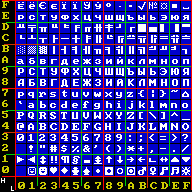ISO/IEC 8859-3:1999, Information technology — 8-bit single-byte coded graphic character sets — Part 3: Latin alphabet No. 3, is part of the ISO/IEC 8859 series of ASCII-based standard character encodings, first edition published in 1988. It is informally referred to as Latin-3 or South European. It was designed to cover Turkish, Maltese and Esperanto, though the introduction of ISO/IEC 8859-9 superseded it for Turkish. The encoding was popular for users of Esperanto, but fell out of use as application support for Unicode became more common.
Big-5 or Big5 is a Chinese character encoding method used in Taiwan, Hong Kong, and Macau for traditional Chinese characters.

Windows-1252 or CP-1252 is a single-byte character encoding of the Latin alphabet, used by default in the legacy components of Microsoft Windows for English and many European languages including Spanish, French, and German.
ISO/IEC 8859-11:2001, Information technology — 8-bit single-byte coded graphic character sets — Part 11: Latin/Thai alphabet, is part of the ISO/IEC 8859 series of ASCII-based standard character encodings, first edition published in 2001. It is informally referred to as Latin/Thai. It is nearly identical to the national Thai standard TIS-620 (1990). The sole difference is that ISO/IEC 8859-11 allocates non-breaking space to code 0xA0, while TIS-620 leaves it undefined.
Windows-1251 is an 8-bit character encoding, designed to cover languages that use the Cyrillic script such as Russian, Ukrainian, Belarusian, Bulgarian, Serbian Cyrillic, Macedonian and other languages.
The Hong Kong Supplementary Character Set is a set of Chinese characters – 4,702 in total in the initial release—used in Cantonese, as well as when writing the names of some places in Hong Kong. It evolved from the preceding Government Chinese Character Set (政府通用字庫) or GCCS. GCCS is a set of supplementary Chinese characters coded in the user-defined areas of the Big5 character set. It was originally used within the Hong Kong Government and later used by the public. It later evolved into Hong Kong Supplementary Character Set when the characters in the set were submitted to ISO-10646 for coding.
Mac OS Roman is a character encoding created by Apple Computer, Inc. for use by Macintosh computers. It is suitable for representing text in English and several other Western languages. Mac OS Roman encodes 256 characters, the first 128 of which are identical to ASCII, with the remaining characters including mathematical symbols, diacritics, and additional punctuation marks. Mac OS Roman is an extension of the original Macintosh character set, which encoded only 217 characters. Full support for Mac OS Roman first appeared in System 6.0.4, released in 1989, and the encoding is still supported in current versions of macOS, though the standard character encodings are now UTF-8 or UTF-16. Apple modified Mac OS Roman in 1998 with the release of Mac OS 8.5 by replacing the currency sign at position hexadecimal 0xDB with the euro sign, but otherwise the encoding has been unchanged since its release.

Code page 855 is a code page used under DOS to write Cyrillic script.

Code page 866 is a code page used under DOS and OS/2 in Russia to write Cyrillic script. It is based on the "alternative code page" developed in 1984 in IHNA AS USSR and published in 1986 by a research group at the Academy of Science of the USSR. The code page was widely used during the DOS era because it preserves all of the pseudographic symbols of code page 437 and maintains alphabetic order of Cyrillic letters. Initially, this encoding was only available in the Russian version of MS-DOS 4.01 (1990) and since MS-DOS 6.22 in any language version.
Windows-1250 is a code page used under Microsoft Windows to represent texts in Central European and Eastern European languages that use Latin script, such as Polish, Czech, Slovak, Hungarian, Slovene, Serbo-Croatian, Romanian and Albanian. It may also be used with the German language; German-language texts encoded with Windows-1250 and Windows-1252 are identical.
Windows-1256 is a code page used under Microsoft Windows to write Arabic and other languages that use Arabic script, such as Persian and Urdu.
Code page 852 is a code page used under DOS to write Central European languages that use Latin script.
Mac OS Cyrillic is a character encoding used on Apple Macintosh computers to represent texts in the Cyrillic script.
Mac OS Central European is a character encoding used on Apple Macintosh computers to represent texts in Central European and Southeastern European languages that use the Latin script. This encoding is also known as Code Page 10029. IBM assigns code page/CCSID 1282 to this encoding. This codepage contains diacritical letters that ISO 8859-2 does not have, and vice versa.
Mac OS Icelandic is a character encoding used in Apple Macintosh computers to represent Icelandic text. It is largely identical to Mac OS Roman, except for the Icelandic special characters Ý, Þ and Ð which have replaced typography characters.
Code page 895 is a 7-bit character set and is Japan's national ISO 646 variant. It is the Roman set of the JIS X 0201 Japanese Standard and is variously called Japan 7-Bit Latin, JISCII, JIS Roman, JIS C6220-1969-ro, ISO646-JP or Japanese-Roman. Its ISO-IR registration number is 14.
MacGreek encoding or Macintosh Greek encoding is used in Apple Macintosh computers to represent texts in the Greek language that uses the Greek script. This encoding is registered as IBM code page/CCSID 1280 and Windows code page 10006.
Code page 856, is a code page used under DOS for Hebrew in Israel.
Each character is shown with its equivalent Unicode code point. Only the second half of the table is shown, the first half being the same as ASCII.
Mac OS Croatian is a character encoding used on Apple Macintosh computers to represent Gaj's Latin alphabet. It is a derivative of Mac OS Roman. The three digraphs, Dž, Lj, and Nj, are not encoded.


